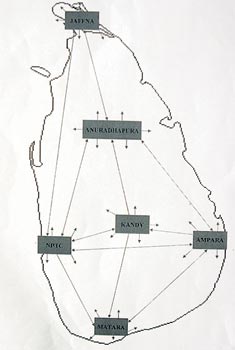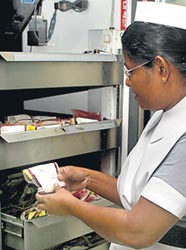|
PUMPING
LIFE TO A LIFELINE
By Kumudini Hettiarachchi
A brand new building
in Narahenpita, a National Blood Policy covering both
the state and private sectors and five centres around
the country in addition to the 'hub' in Colombo are
the latest developments in the blood transfusion service
of Sri Lanka.
 |
| Dr. (Mrs.) R.M. Bindusara |
No other country in
South Asia has a National Blood Policy for both the
state-private sector, explains the Director of the National
Blood Transfusion Service, Dr. (Mrs.) R.M. Bindusara,
adding that an Act of Parliament is on the cards shortly.
Seated in her new
office, part of the elegant structure that has come
up adjacent to the Anti-Malaria Campaign building, Dr.
Bindusara travels down memory lane to the time she took
over as Director in 1995. By that time she had already
been in the blood transfusion service since 1983 working
in the periphery for about 10-15 years.
"At that time blood transfusion
was a degraded subject. The Blood Bank was in the National
Hospital of Colombo and the staff working there had
no discipline or the correct attitude. They were frustrated
working in an unhealthy environment.”
In 1990 having seen the Blood Bank
in the United Kingdom, she realized the potential of
this crucial field.
 |
| Just before the blood is stored.
Pix by M.A. Pushpa Kumara |
Drastic changes were needed not only
in the form of a new building but also in the attitude
of the people working in this field.
For three years her
proposal for a new building went back and forth. The
External Resources Department (ERD) was coordinating
the foreign aid flow and at important meetings with
donors, directors from different departments had to
bid for funding.
The ERD Director at
that time advised them not to fight in front of the
donors but to prioritize. "In 1997, I felt I was
going nowhere and at a meeting gave my card to a Japanese
delegation and invited them to come visit the Blood
Bank," she says adding that to her surprise they
were there the next morning. "They looked into
the fridges, saw the broken wires hanging all round
and the rats running about," she says.
Two days later there
was a wrap-up meeting, and shocked to see the state
of the National Blood Bank, her proposal for a new building
was taken up. They themselves suggested that they should
do a feasibility study. She, meanwhile, readily agreed
to get technical assistance from the WHO.
Later at a meeting
Dr. Bindusara had with then Prime Minister Sirimavo
Bandaranaike she pointed out the need to improve the
blood transfusion service in the country and realizing
its importance the PM put her letter to the National
Health Council where all the ministers were represented.
 |
| The elegant building which will
be home to the National Blood Transfusion Service
in Narahenpita will be opened on November 2. |
That was the start
of a major turn-around in the transfusion service. Whereas
in 1995, there were only 35 hospital-based Blood Banks
now there are 70.
By this time due to the decisions
taken by successive Health Ministers A.H.M. Fowzie and
Nimal Siripala de Silva, she and her staff had moved
to two floors of the Anti-Malaria Campaign building
in Narahenpita in 2001.
"We modelled two floors on the
same way we would have our new centre," says Dr.
Bindusara smiling that it was a major morale-booster
to the staff. "They are now proud of the job they
are doing."
The hospital-based Blood Banks those
days used to cater only to individual hospitals and
the policy was le dunnoth dennam. People with influence
got blood and the poor suffered.
 |
| The five centres |
"After much discussion with doctors,
we decided to move away from the hospital to a centre
concept. Now there are five centres across the country,
while the National Blood Transfusion Service is responsible
for blood for the entire country," she says.
Another aspect that needed attention
was the stagnant position of the medical officers in
this field. "There was no future for them,"
explains Dr. Bindusara adding that after negotiation
with the Post-Graduate Institute of Medicine, firstly
a Diploma was introduced followed by an MD. "Earlier
there were only 125 doctors in the service, now we have
300. Most centres have a diploma holder, while some
have gone into the private sector. With the introduction
of the MD, there are two Transfusion Medicine Consultants,"
she says.
 |
| Nursing Officer Premalatha in
the blood storage area. |
Then arose the question: What was
the purpose of having MDs and buildings if there was
no blood? We needed voluntary blood donation and for
that we got some marketing people activated.
"Voluntary blood donation and
clinical use of blood - there was a waste risk. Now
there were MDs to talk to other consultants. Most hospitals
we have spoken to on the subject of clinical use of
blood have set up transfusion committees who will hold
a meeting once in six months among the administration,
consultants and the hospital-based Blood Bank. One of
our representatives will also attend these meetings,"
she says.
Our work is a wonderful multi-sectoral
job. We have to dabble in public health, advise people
on nutrition after checking the haemoglobin level, discuss
diseases such as HIV and urge the people to seek medical
assistance. People can talk to us and be counselled
at no charge, she adds. “ If there is a will there
is a way.”
| 